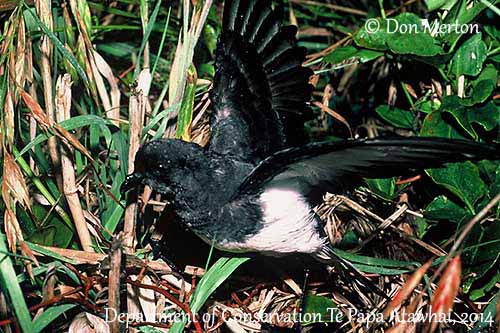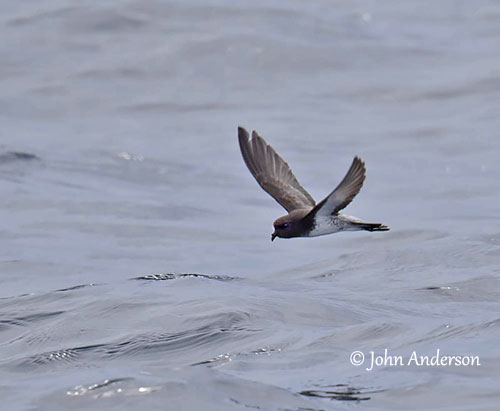
Fr: Océanite néréide
Ang: Grey-backed Storm-Petrel
All: Graurücken-Sturmschwalbe
Esp: Paíño Dorsigrís
Ita: Uccello delle tempeste dorsogrigio
Nd: Grijsrugstormvogeltje
Sd: gråryggig stormsvala
Photographers:
John Anderson
John Anderson Photo Galleries
Don Merton
Courtesy of Department of Conservation Te Papa Atawhai, 2014
Department of Conservation
Title: Grey-backed Storm Petrel
Photographer: Merton, Don
Date: 1984
Location: Chatham Islands Area
Description: Grey-backed storm petrel with wings out stretched, South East Island, Chatham Islands, December 1984
Text by Nicole Bouglouan
Sources :
HANDBOOK OF THE BIRDS OF THE WORLD vol 1 by Josep del Hoyo-Andrew Elliot-Jordi Sargatal - Lynx Edicions - ISBN: 8487334105
A Complete Guide to Antarctic Wildlife by Hadoram Shirihai and Illustrated by Brett Jarrett - Edited by Guy M. Kirwan - ALUL.A Press Oy, Finland - ISBN 9519894705
Albatross encounter… Kaikoura, New Zealand
Notornis, 2006,Vol. 53: 317-318 - 0029-4470 © The Ornithological Society of New Zealand, Inc.
An unprecedented influx of grey-backed storm petrels (Garrodia nereis) in the Hauraki Gulf, northern New Zealand
New Zealand birds and birding (Narena Olliver)
Neotropical Birds – Cornell Lab of Ornithology
New Zealand bird status between 2008 and 2012
Grey-backed Storm-Petrel
Garrodia nereis
Procellariiformes Order – Oceanitidae Family
INTRODUCTION:
The Grey-backed Storm-Petrel is now included in the family Oceanitidae, apart from the family Hydrobatidae. It is the only member of the genus Garrodia. This species occurs in Southern Ocean. It differs from other storm-petrels by the grey back and inner part of the wing, and the pale grey rump instead of white.
The Grey-backed Storm-Petrel is vulnerable on land, and predation by the Brown Skua is a major threat at breeding colonies. It is mainly solitary, although sometimes seen in small groups. They nest in loose colonies.
The Grey-backed Storm-Petrel is the smallest storm-petrel in the New Zealand region, but this sparrow-sized bird has very powerful flight in full force gales in New Zealand subantarctic waters.
DESCRIPTION OF THE BIRD:
Biometrics:
Length: 16-19 cm
Wingspan: 39-40 cm
Weight: 35 g (21-44 g)
The adult has blackish-grey head, throat, neck and upper breast, whereas mantle, back and wings are dark grey. On the upperwing, two pale wingbars are formed by the pale grey tips of both median and greater coverts. Rump and uppertail-coverts are pale grey to silvery grey. The rectrices are darker grey at base, and mostly blackish-grey at tip, forming a dark terminal band.
In fresh plumage, the upperparts have scaly appearance due to the pale-tipped feathers.
The underparts are white and contrast strongly with the dark hood. On the underwing, the trailing edge is dark grey and the leading edge is dark and broader. The flanks may sometimes show grey streaks while some grey bars are visible on the undertail-coverts.
The bill is black. The eyes are dark brown. Legs and webbed feet are grey-black.
Male and female have similar appearance, although female is usually larger overall.
The juvenile is similar to adults.

RANGE:
The Grey-backed Storm-Petrel has circumpolar range. It occurs in Southern Ocean in Falklands, South Georgia, Gouth, Crozet, Kerguelen, Auckland, Antipodes, Chatham and possibly Macquarie Islands.
HABITAT:
The Grey-backed Storm-Petrel occurs at sea and often near its breeding grounds on islands. The breeding colonies are established on flat, sloping or sometimes steep areas, usually in dense tussac grassland or heath.
Outside the breeding season, it is marine and pelagic. It can be found in the cool waters over the edge of the continental shelf in subantarctic zone.
CALLS AND SONGS: SOUNDS BY XENO-CANTO
While on the ground at the breeding colonies, the Grey-backed Storm-Petrel utters monotonous, dissyllabic chirps similar to harsh cricket-like calls. Some softer calls can be heard too. But this species is silent at sea.
BEHAVIOUR IN THE WILD:
The Grey-backed Storm-Petrel feeds on barnacle larvae (Lepas australis) which are usually its main food. But it also takes crustaceans and occasionally small fish. It is often associated with floating kelp at sea, where it can feed on barnacles.
Like other Hydrobatidae, it feeds by pattering. The bird faces into the wind with outstretched wings to keep the balance while trailing the legs in the water. It hovers and performs pattering runs while seizing food items with the bill. Other techniques such as aerial-dipping and shallow-plunging are used too.
It feeds alone but sometimes in small groups.
The Grey-backed Storm-Petrel is monogamous with long-term pair-bonds. Both adults share all the nesting duties. The courtship displays include aerial chases by two or more birds performing fast flying in circles above the nesting site while calling loudly. The major part of the sexual activity takes place in the nest, and especially in the nest-chamber. Both mates perform mutual preening, bill-touching and calling. During the copulation, the male bites or preens the feathers of the female’s nape. They breed in loose colonies.
The Grey-backed Storm-Petrel disperses after breeding, but it usually remains in waters near the breeding areas. This behaviour varies according to the range. The species is resent all year round around the Chatham Islands, but it is absent from Crozet in winter. Some birds occur off SE Australia and Tasmania. It is rare in New Zealand (except in Hauraki Gulf in 1981, where thousands of individuals reached this area). There are some records from South Africa.
The Grey-backed Storm-Petrel performs fast, direct flight, often close to the water surface. This species is a powerful flier, even in strong winds.
REPRODUCTION OF THIS SPECIES:
The Grey-backed Storm-Petrel establishes the breeding colonies on oceanic islands. These colonies are mainly active between August and April. The pre-laying exodus lasts about two weeks. The birds are strictly nocturnal around their nests to avoid predation.
The nest is mainly above the ground instead of excavated burrow. It is very well hidden among the dense vegetation, usually a clump of tussock grass or flax. For better protection, the birds build a small tunnel leading to the nest but invisible in the vegetation. However, this species may also nest in rock crevices.
The female lays a single white egg with some spots at the broader end. Both adults incubate during 45 days with stints of 1-3 days. At hatching, the chick has dark grey down overall. It is brooded only during 24 hours, and fed every 36 hours. It reaches the adult weight at 17 days old. The young fledges about 50 days after hatching.
This species produces only one brood per year.
PROTECTION / THREATS / STATUS:
The Grey-backed Storm-Petrel is affected by predation on the breeding grounds by the Short-eared Owl in Falklands, and elsewhere by skuas, rats and cats. All predators take adults, eggs and chicks. Declines are reported due to fairly accessible nesting sites. Another problem comes from the livestock, involving trampling and degradation of the vegetation on the breeding grounds.
The global population is estimated at 200,000 individuals, with the main concentration on the islands around New Zealand.
But currently, the Grey-backed Storm-Petrel is evaluated as Least Concern.
